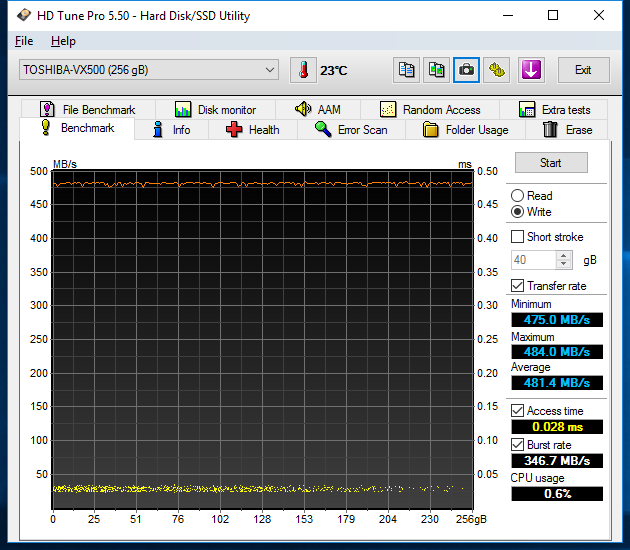HDTUNE
HD Tune is a Hard Disk Utility with many functions from error checking, health testing (S.M.A.R.T.), and of course benchmarking. To build upon our real world write test we also looked to see where the write speeds leveled off to by using HD Tune Pro. If SLC caching is being utilized, this test will typically show it.
For one last benchmark we are yet again utilizing HDTune. HDTune shows us that the average write speed for the VX500 did not drop off like other SSDs with SLC write caching. The 256GB model averaged 481MB/s while the two larger capcities averaged 490MB/s.
REPORT ANALYSIS AND FINAL THOUGHTS
Throughout testing the VX500 gave us some mixed results, though for the most part, they were positive. Sequential speeds easily matched their rated specifications of up to 550MB/s read and 515MB/s write. It reached its up to 90K IOPS read and 65K IOPS ratings. The one thing which was low was its 4K QD1 performance. In looking at the results of these metrics, the VX500 was slower than its predecessor with speeds of around 25MB/s read and 140MB/s write.
These results, however, did not reflect how the VX500 performed in our trace based and real world benchmarks. In these tests the VX500 did rather well. In PCMark Vantage it averaged 78K points across all capacities. In PCMark 8 Extended the VX500 placed among the best MLC based drives in the market in both the steady state and recovery phases. In transferring our 30GB of files over to the VX500 it maintained speeds above the rated write speed and ranked it among average. However, during our look at the efficiency of the SSD we saw that the VX500 turned out to be the most efficient drive we have put through that test yet. It even beat out competitors with more power efficient 3D TLC NAND. To top it off, we saw that the new architecture helped to improve the idle power consumption as well with much better results than that of the VR180.

FINAL THOUGHTS
The DRAM-less architecture did not break the VX500 in today’s review, if anything, it actually pushed it to be the most power efficient SSDs we have tested to date. This is great to hear for those who are in need of a replacement SSD for use in a laptop or other mobile device that can utilizes a 2.5″ 7mm SATA SSD. When looking the VX500’s performance, the 4K QD1 results were lower than we typically would like, but it redeemed itself in our trace based tests and real world transfer testing. Overall, it is a strong performer in the mainstream segment.

In addition to its strong performance, the VX500 comes bundled with a great 5-year warranty, migration software, an SSD toolbox, and has some great endurance figures. Considering all of this, as well as its competitive introductory MSRPs, the Toshiba OCZ VX500 proves to be a very good choice for almost any consumer looking to get a new SATA based SSD. For that very reason we have no problem in giving this SSD our Gold Seal of approval!
 The SSD Review The Worlds Dedicated SSD Education and Review Resource |
The SSD Review The Worlds Dedicated SSD Education and Review Resource | 

Where is the hd tune pro chart to see what happens after slc runs out?
After running HDTune on all capacities we tested there was no drop off in write performance. All maintained about 490MB/s write across the board.
That sounds like one of the highest read / write averages for a sata3 ssd from start to finish. Am I right? Thank goodness for mlc.
It is up there for sure. We have not tested write performance with many other MLC SSDs in HDTune so I can not say for sure one of the highest, but it sure is good!
Now that’s the way a HD Tune chart should look. Nice! I hope they keep making mlc drives because I cant believe companies are still trying to sell us on write speed does not matter. If we wanted slow write speeds we would stick with hard drives.
I find it highly unlikely, that 256GB model can hit sustained 490MB/s write. MLC is good, but not that good. That would require 64Gbit dies to achieve.
The heading / advertisement should read. This mlc ssd is not just good its great!
I get sick of seeing this nonsense… ‘Once formatted the 256GB model has 238GB of usable space’.
You should know better, it’s simply a difference of GB vs GiB.
The majority of our readers do not know this unfortunately and thus we provided this information as we do.
Actually, the statement is 100% correct. Typical consumers, and in fact, the industry does not advertise or speak of GiB whatsoever in discussing available volume on a SSD. The SSD is a consumer directed SSD and 99.9% of consumers don’t understand GiB whatsoever. They want and deserve to know how much logical space is available to them when the drive is formatted. The freedom to read what we wish is an amazing thing.
I found it funny you got so defensive.
You should be trying at least to educate your readership, rather than just perpetuating myths about lost space through formatting.
You have a strange sense of humour.
You criticized, and Les responded. Yes, that’s defensive.
While your first comment might be true, you shouldn’t be surprised that Les explained why he writes what/how he does… which is also true.
Thank you.
I dont recall ever stating, or rather Sean writing that space was lost after formatting. He simply stated the available space after the drive was formatted. Should he then have to say that, before formatting, there is no available space for storage? Nobody ever spoke of lost space, but rather, at least I think you sought the opportunity to perpetuate the whole GB/GiB scenario.